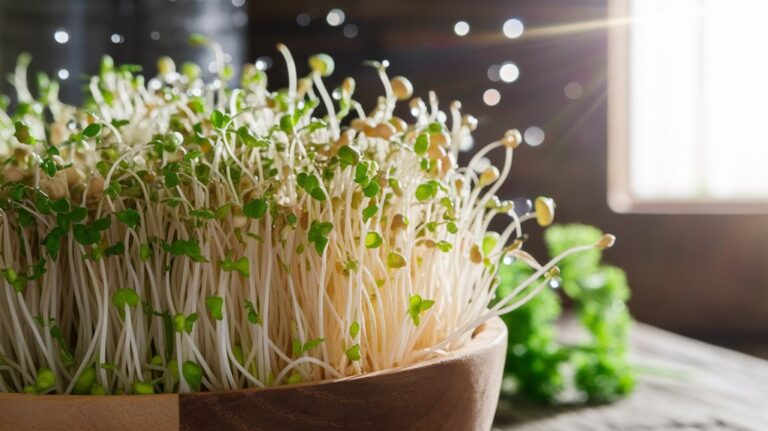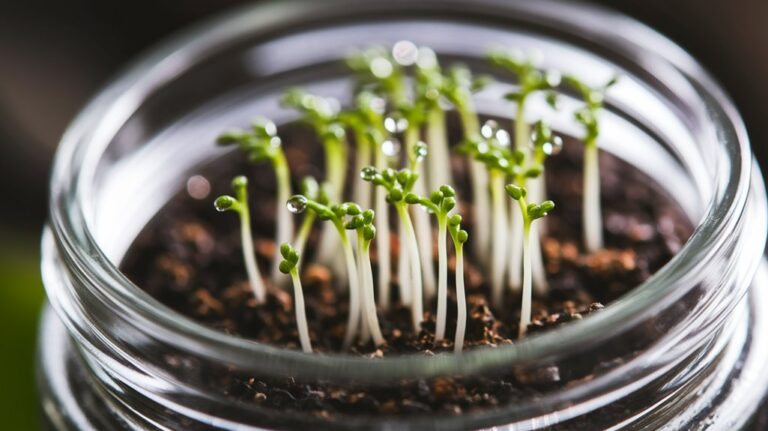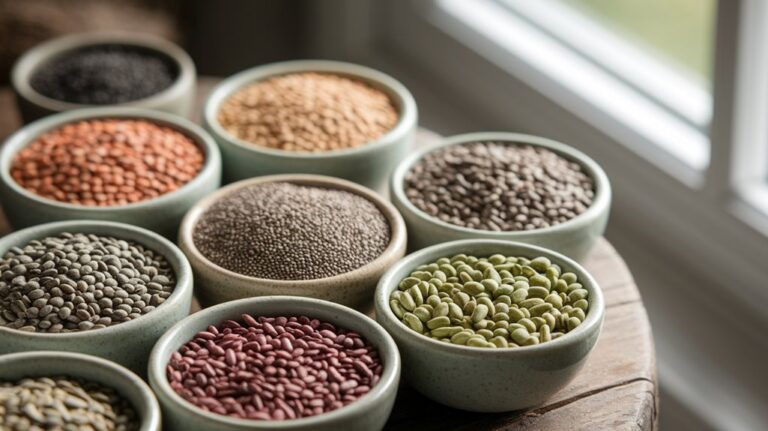Year-Round Sprouts Availability
Sprouts are a fantastic year-round addition to my diet, offering a wealth of nutrients, low calories, and loads of flavor. I love how varieties like alfalfa and radish can be grown anytime, while mung bean sprouts thrive in warm months. Growing them at home is simple and environmentally friendly, giving me fresh produce regardless of the season. Plus, I can enhance my salads and smoothies with these nutritious gems. Stick around to discover more about their culinary uses and benefits!
Key Takeaways
- Sprouts like radish and alfalfa can be grown year-round, providing fresh produce regardless of the season.
- Mung bean sprouts thrive in warmer months, while alfalfa sprouts are best in cooler weather, ensuring seasonal variety.
- Home sprouting allows for continuous access to nutritious greens with minimal resources and space.
- Cultivating sprouts supports local food systems and enhances food security through consistent availability.
- Proper handling and preparation of sprouts can mitigate safety concerns, encouraging year-round consumption.
The Nutritional Benefits of Sprouts
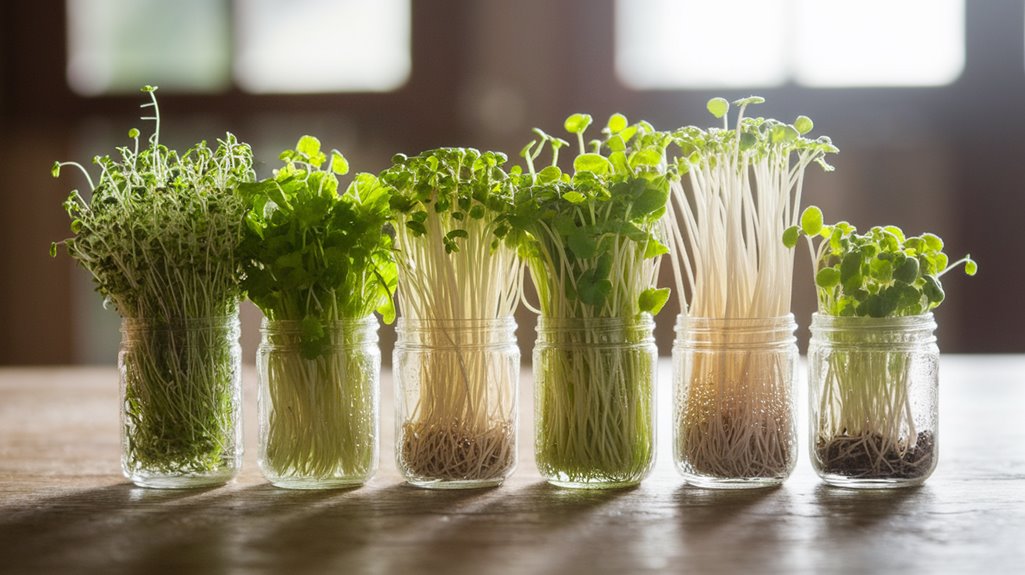
When I think about the nutritional benefits of sprouts, it’s hard not to get excited about their potential to enhance our diets.
These tiny powerhouses are packed with vitamins, minerals, and antioxidants that support overall health. For instance, sprouts like alfalfa and broccoli are rich in vitamin C, which boosts our immune system.
They also contain fiber that aids digestion and promotes gut health. What I find fascinating is that they’re low in calories yet high in nutrients, making them a fantastic addition to any meal.
Plus, their enzymes can assist in breaking down food, making it easier for our bodies to absorb nutrients. Incorporating sprouts into my diet not only adds crunch but also elevates the nutritional value of my meals.
Types of Sprouts and Their Seasonal Availability
When I think about the world of sprouts, I’m fascinated by the variety and how they thrive in different seasons.
Each type, from alfalfa to broccoli, has its unique growth patterns that influence when we can enjoy them fresh.
Let’s explore these common sprout varieties and their seasonal availability to enhance our culinary experiences year-round.
Common Sprout Varieties
Sprouts offer a delightful burst of flavor and nutrition, making them a staple in many kitchens. Among the most common varieties, alfalfa sprouts stand out for their crisp texture and mild taste, perfect for salads and sandwiches.
Broccoli sprouts are another favorite, packed with antioxidants and a slightly peppery flavor. If you enjoy a more robust taste, try radish sprouts; they add a spicy kick to any dish.
Then there are mung bean sprouts, often used in stir-fries, delivering a satisfying crunch. Each variety brings unique benefits and flavors, making it easy to incorporate them into any meal.
Seasonal Growth Patterns
Incorporating a variety of sprouts into your meals not only enhances flavor but also aligns with their seasonal growth patterns. For instance, alfalfa sprouts thrive during cooler months, making them perfect for winter salads.
In contrast, mung bean sprouts flourish in warmer temperatures, adding a refreshing crunch to summer dishes.
As I explore the seasonal availability of sprouts, I find that broccoli sprouts are typically harvested in spring, providing a nutrient boost just as fresh produce becomes abundant.
Meanwhile, radish sprouts can be grown quickly in any season, offering versatility throughout the year.
Understanding these patterns helps me choose the right sprouts for my cooking, ensuring that I enjoy the freshest flavors while supporting sustainable practices.
How to Grow Sprouts at Home
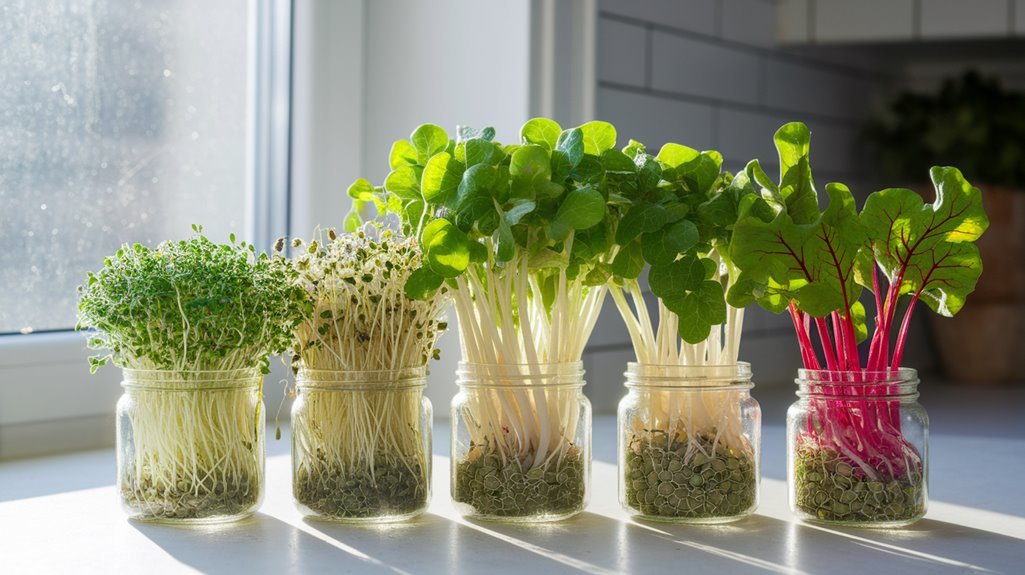
Although growing sprouts at home may seem daunting, I can assure you it’s a simple and rewarding process.
First, choose your seed variety—mung beans, lentils, or alfalfa are great options. Rinse the seeds thoroughly and soak them in water for about 6-8 hours.
Drain the water and transfer the seeds to a sprouting jar or tray. Keep them in a dark, well-ventilated area, rinsing them with water twice a day.
In just a few days, you’ll see tiny sprouts emerging! Once they reach about 1-2 inches in length, they’re ready to eat.
I love adding them to salads and sandwiches. With minimal effort, you can enjoy fresh, nutritious sprouts right from your kitchen!
Sprouts in Culinary Traditions Around the World
When exploring the rich tapestry of global cuisine, I often find that sprouts play a pivotal role, adding texture and flavor to various dishes.
In Asian culinary traditions, mung bean sprouts are essential in stir-fries and salads, offering a crisp bite that complements savory flavors.
Meanwhile, in the Middle East, alfalfa sprouts grace fresh tabbouleh, contributing a refreshing crunch.
European cuisines, too, embrace sprouts, with lentil sprouts featured in hearty soups and salads.
Even in Latin America, I’ve discovered sprouted grains in traditional recipes, enhancing both nutrition and taste.
Each culture showcases sprouts uniquely, revealing their versatility and nutritional benefits.
It’s fascinating how these tiny powerhouses can elevate dishes across the globe, connecting us through shared culinary experiences.
Creative Ways to Incorporate Sprouts Into Your Diet
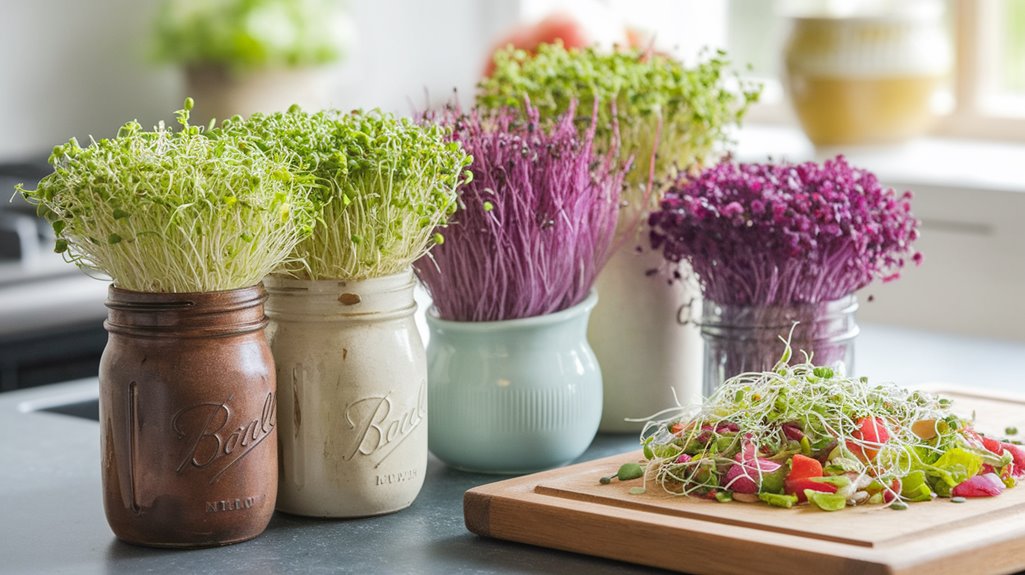
I love finding new ways to add sprouts to my meals, and salads are a perfect canvas for their crunchy texture and fresh flavor.
Sprouts can also elevate your morning smoothie, providing a nutritious boost without overpowering the taste.
Let’s explore how these tiny powerhouses can enhance your dishes and keep your diet exciting!
Sprouts in Salads
Sprouts can transform a simple salad into a nutrient-packed powerhouse, making it easy to incorporate these tiny nutritional giants into your diet.
I love adding a handful of alfalfa or broccoli sprouts to my leafy greens; they provide a delightful crunch and a burst of flavor. You can also mix in some radish sprouts for a peppery kick that livens up any bowl.
If you’re feeling adventurous, try a sprout medley with chickpeas, cherry tomatoes, and a zesty lemon vinaigrette. Not only do sprouts enhance the taste and texture, but they also boost the salad’s vitamin content significantly.
With so many varieties available, you can experiment and find your perfect combination, ensuring your salads are as exciting as they’re nutritious!
Sprouts in Smoothies
Incorporating sprouts into smoothies not only enhances their nutritional profile but also adds a unique texture and flavor that can elevate your morning routine.
I love experimenting with different combinations to create delicious, health-packed drinks. Here are four creative ways I’ve found to include sprouts in my smoothies:
- Alfalfa Sprouts: They add a mild, nutty flavor and boost vitamin K.
- Broccoli Sprouts: Packed with antioxidants, they lend a slightly peppery taste.
- Mung Bean Sprouts: They provide a crunchy texture and are rich in protein.
- Radish Sprouts: Their zesty kick adds a fun twist to any blend.
Try these additions to make your smoothies not just tasty, but also a powerhouse of nutrients!
Sprouts vs. Other Vegetables: A Nutritional Comparison
While many vegetables offer a range of health benefits, sprouts stand out for their unique nutritional profile. I often find myself amazed at how nutrient-dense they are, packed with vitamins, minerals, and antioxidants.
For instance, alfalfa sprouts deliver high levels of vitamin K, while broccoli sprouts boast a significant amount of sulforaphane, known for its cancer-fighting properties.
Compared to traditional vegetables like carrots or spinach, sprouts typically have lower calories and higher concentrations of certain nutrients. Plus, they’re easier to digest, thanks to the sprouting process, which enhances nutrient bioavailability.
If you’re looking to boost your diet, incorporating a variety of sprouts can provide essential nutrients that might be lacking in other vegetables. It’s a simple yet effective way to elevate your meals.
Storing and Preserving Sprouts for Freshness
When I think about how to keep sprouts fresh and flavorful, proper storage techniques come to mind.
Here are some methods I’ve found effective:
- Refrigerate Immediately: After purchasing or harvesting, store sprouts in the fridge as soon as possible to slow spoilage.
- Use a Breathable Container: Place sprouts in a container that allows airflow, like a perforated bag or a loosely closed cloth.
- Avoid Moisture: Excess moisture can lead to sliminess, so it’s best to dry sprouts gently before storing.
- Consume Quickly: Aim to eat your sprouts within a week for maximum freshness and nutrients.
Common Misconceptions About Eating Sprouts
Many people believe that eating sprouts is risky due to potential foodborne illnesses, but this misconception often overshadows their nutritional benefits. While it’s true that sprouts can carry bacteria, proper handling and preparation significantly reduce these risks.
I’ve found that rinsing sprouts thoroughly and keeping them refrigerated can make a huge difference. Sprouts are packed with vitamins, minerals, and antioxidants, making them a powerhouse addition to any diet. Additionally, they’re low in calories and can enhance flavors in salads and sandwiches.
The Environmental Impact of Growing Sprouts Year-Round
As I explore the environmental impact of growing sprouts year-round, it becomes clear that this practice offers a sustainable solution to food production.
By cultivating sprouts consistently, we can significantly reduce our ecological footprint. Here are four key benefits I see:
- Low Water Usage: Sprouts require minimal water compared to traditional crops, conserving this precious resource.
- Reduced Land Requirements: Growing sprouts indoors or in small spaces minimizes the need for expansive farmland.
- Short Growth Cycle: Sprouts mature quickly, allowing for faster harvests and less energy consumption.
- Decreased Transportation Emissions: Local production cuts down on greenhouse gas emissions associated with transporting food.
Embracing year-round sprouts can be a game-changer for sustainable living.
Frequently Asked Questions
Conclusion
In conclusion, embracing year-round sprouts can truly enhance your diet and well-being. With their rich nutritional profile and versatility in the kitchen, sprouts are a powerhouse ingredient. Whether you choose to grow them at home or incorporate them into your meals, the benefits are undeniable. Plus, understanding their environmental impact can make your choices even more meaningful. So, let’s celebrate these tiny greens and explore all the delicious ways they can enrich our lives!



